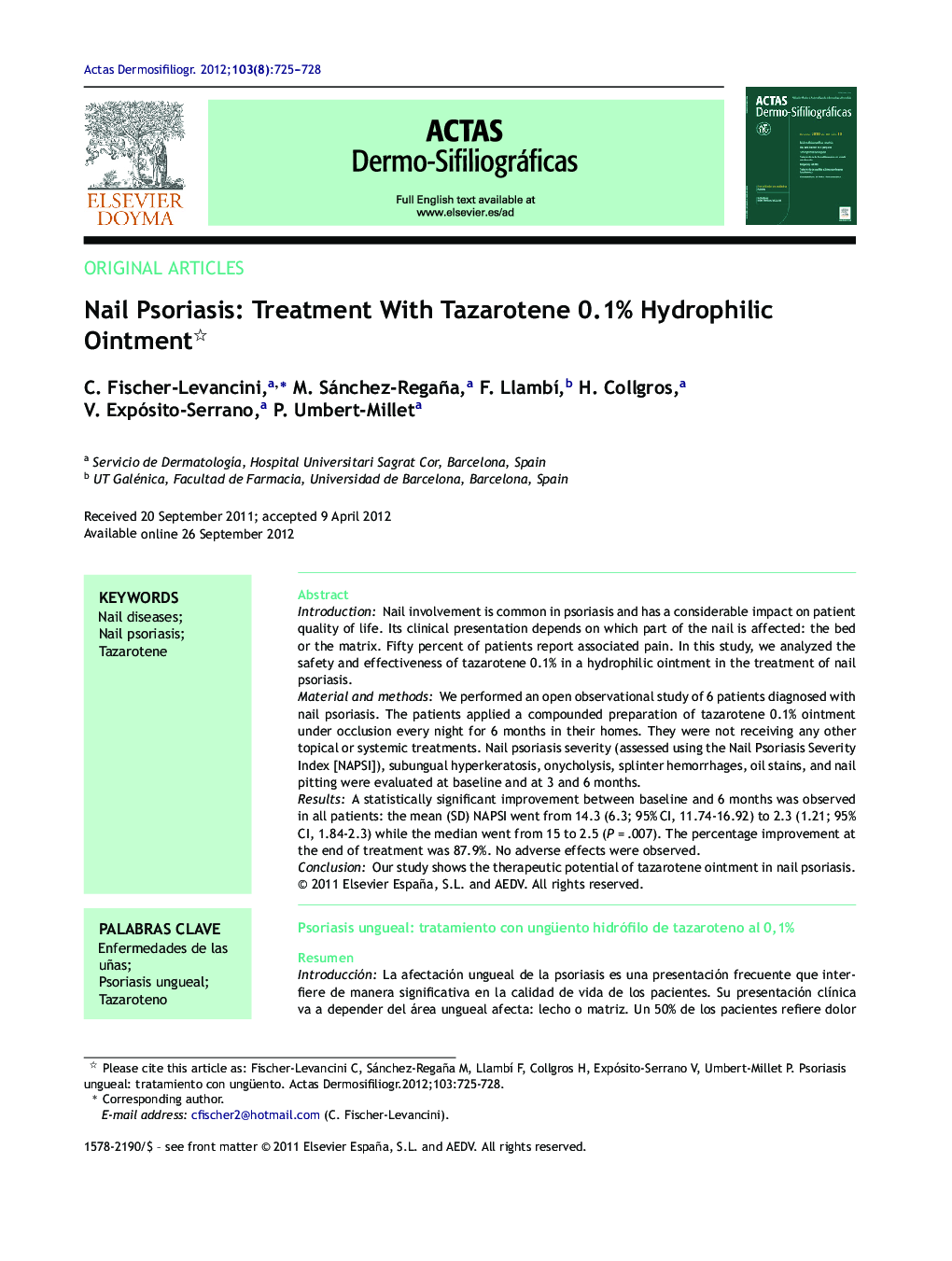| Article ID | Journal | Published Year | Pages | File Type |
|---|---|---|---|---|
| 3183173 | Actas Dermo-Sifiliográficas (English Edition) | 2012 | 4 Pages |
IntroductionNail involvement is common in psoriasis and has a considerable impact on patient quality of life. Its clinical presentation depends on which part of the nail is affected: the bed or the matrix. Fifty percent of patients report associated pain. In this study, we analyzed the safety and effectiveness of tazarotene 0.1% in a hydrophilic ointment in the treatment of nail psoriasis.Material and methodsWe performed an open observational study of 6 patients diagnosed with nail psoriasis. The patients applied a compounded preparation of tazarotene 0.1% ointment under occlusion every night for 6 months in their homes. They were not receiving any other topical or systemic treatments. Nail psoriasis severity (assessed using the Nail Psoriasis Severity Index [NAPSI]), subungual hyperkeratosis, onycholysis, splinter hemorrhages, oil stains, and nail pitting were evaluated at baseline and at 3 and 6 months.ResultsA statistically significant improvement between baseline and 6 months was observed in all patients: the mean (SD) NAPSI went from 14.3 (6.3; 95% CI, 11.74-16.92) to 2.3 (1.21; 95% CI, 1.84-2.3) while the median went from 15 to 2.5 (P = .007). The percentage improvement at the end of treatment was 87.9%. No adverse effects were observed.ConclusionOur study shows the therapeutic potential of tazarotene ointment in nail psoriasis.
ResumenIntroducciónLa afectación ungueal de la psoriasis es una presentación frecuente que interfiere de manera significativa en la calidad de vida de los pacientes. Su presentación clínica va a depender del área ungueal afecta: lecho o matriz. Un 50% de los pacientes refiere dolor asociado. En este estudio evaluamos la eficacia y seguridad del tazaroteno 0,1% en ungüento hidrófilo.Material y métodosEstudio abierto y observacional de 6 pacientes diagnosticados de psoriasis ungueal. Se aplicó ungüento de tazaroteno 0,1% (fórmula magistral) en oclusión nocturna, en su domicilio durante 6 meses, sin otro tratamiento tópico o sistémico. Se determinó el Nail Psoriasis Severity Index (NAPSI) y se evaluaron la hiperqueratosis subungueal, onicólisis, hemorragias en astilla, manchas de aceite y piquiteado ungueal, en la visita basal, a los 3 y 6 meses.ResultadosSe observó una mejoría estadísticamente significativa en todos los pacientes: NAPSI basal, media ± DE 14,3± 6,3; IC 95% 11,74-16,92; mediana 15; NAPSI a los 6 meses: media ± DE 2,3 ±1,21; IC 95% 1,84-2,83; mediana 2,5; p = 0,007. El porcentaje de mejoría fue del 87,9% al final del tratamiento. No se registraron efectos adversos.ConclusiónNuestro estudio muestra un potencial terapéutico del ungüento de tazaroteno en la psoriasis ungueal.
